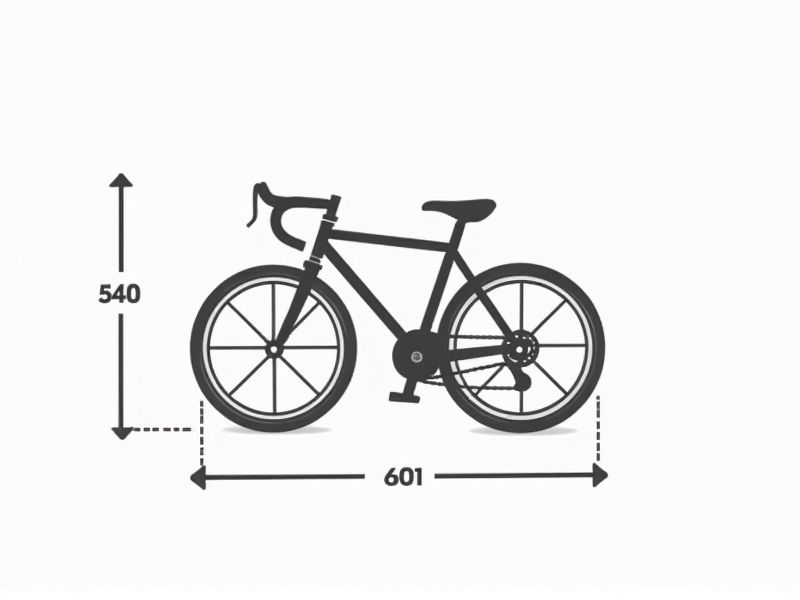
When selecting a bike, understanding standard dimensions helps ensure comfort and safety. Most adult bicycles have a wheel diameter of either 26 inches, 27.5 inches, or 29 inches, while children's bikes typically use 12 to 24-inch wheels. Frame sizes are usually measured in inches or centimeters from the center of the bottom bracket to the top of the seat tube, with common adult frame sizes ranging from 15 to 22 inches (38 to 56 cm). Choosing the right size--based on your height and intended use--will improve your cycling experience and help prevent injury.
Wheelbase
The wheelbase of a bike directly affects its stability, handling, and comfort, with typical measurements ranging from 38 to 45 inches for most road and mountain bikes. A longer wheelbase generally offers greater stability at high speeds, making it ideal for downhill rides, while a shorter wheelbase enhances maneuverability, beneficial for tight turns and urban riding. When selecting a bike, consider your riding style; for example, a longer wheelbase suits long-distance touring, while a shorter one is preferable for agile, city commuting. Proper wheelbase length can significantly enhance your cycling experience, providing a blend of performance and comfort tailored to your preferences.
Seat Height
Seat height is a crucial factor in bike comfort and performance, typically ranging from 28 to 34 inches on most models. Proper seat height allows for optimal leg extension, which can enhance pedaling efficiency and reduce the risk of injury. You should adjust the seat so your leg has a slight bend at the bottom of the pedal stroke, improving overall cycling experience. When considering mountain bikes or road bikes, ensure that the seat height accommodates your body type for the best ride quality.
Frame Size
When selecting a bike, the frame size is crucial for comfort and performance. A properly fitted bike frame significantly enhances your riding experience, reducing the risk of injury and improving efficiency. For adult cyclists, the standard frame size typically ranges between 14 to 24 inches, with specific measurements based on height and inseam length. Investing in a custom fitting can maximize your bike's potential and significantly impact your overall riding enjoyment.
Handlebar Width
Handlebar width significantly influences your cycling experience, with standard widths ranging from 38 to 46 cm, tailored for various body types and riding styles. A narrower handlebar, around 38-40 cm, is ideal for riders with smaller frames and enhances aerodynamics, while wider options, such as 42-46 cm, provide better stability and control for larger cyclists. Your comfort and efficiency are maximized when the handlebar width aligns with your shoulder width, as it allows for a more natural grip and posture. Selecting the correct handlebar width can improve your handling, power transfer, and overall enjoyment during rides.
Top Tube Length
Top tube length is a crucial measurement in determining bike fit and performance. Ranging from 500 mm to 700 mm, this dimension affects your reach and overall riding comfort. A shorter top tube typically suits riders who prefer a more upright position, while a longer one caters to those seeking improved aerodynamics. Ensuring your bike's top tube length aligns with your body geometry can significantly enhance your cycling experience.
Head Tube Angle
The head tube angle, ranging from 68 to 75 degrees, significantly influences a bike's handling and stability. A steeper angle, around 75 degrees, typically enhances responsiveness, making it ideal for racing and agile maneuvers. Conversely, a slacker angle closer to 68 degrees promotes more stability, beneficial for downhill cycling and rugged terrains. Your choice of head tube angle should align with your riding style, whether it's swift road rides or challenging off-road adventures.
Chainstay Length
The chainstay length of a bike significantly influences your riding experience, typically ranging from 400 mm to 450 mm for most models. A shorter chainstay, around 400 mm, enhances maneuverability, making it ideal for aggressive riding and tight turns, while a longer chainstay offers improved stability, averaging about 450 mm, suitable for endurance and long-distance cycling. Brands like Trek and Specialized design specific models with tailored chainstay lengths to optimize performance for different cycling disciplines. By selecting the appropriate chainstay length, you can enhance your bike's handling characteristics to better match your riding style and preferences.
Bottom Bracket Height
Bottom bracket height (BBH) is a crucial measurement influencing your bike's handling and stability, typically ranging from 11.5 to 14 inches. A lower BBH enhances cornering agility, making your ride feel more responsive, especially during aggressive maneuvers. Conversely, higher bottom brackets increase ground clearance, beneficial for tackling rough terrains or obstacles without risking pedal strikes. When selecting a bike, consider how the BBH aligns with your riding style; a well-suited height can significantly enhance your overall cycling experience.
Fork Rake
Fork rake, an essential measurement in bicycle design, significantly influences handling and stability. Typically ranging from 40mm to 70mm, the fork rake affects how quickly your bike responds to steering inputs. A smaller fork rake provides enhanced maneuverability, ideal for tight turns, while a larger rake contributes to stability at higher speeds. Understanding your bike's fork rake can help you tailor your riding experience, whether you prioritize agility or steadiness on various terrains.
Standover Height
Standover height is a crucial measurement when selecting a bike, as it directly affects your comfort and control. This measurement typically ranges from 25 to 35 inches, depending on the bike type and frame size, ensuring that riders can easily mount and dismount. A standover height that allows for at least 1-2 inches of clearance provides a safer riding experience, especially in stop-and-go situations. When choosing your bike, always consider your inseam length in relation to the standover height for the best fit and performance on the road or trail.
